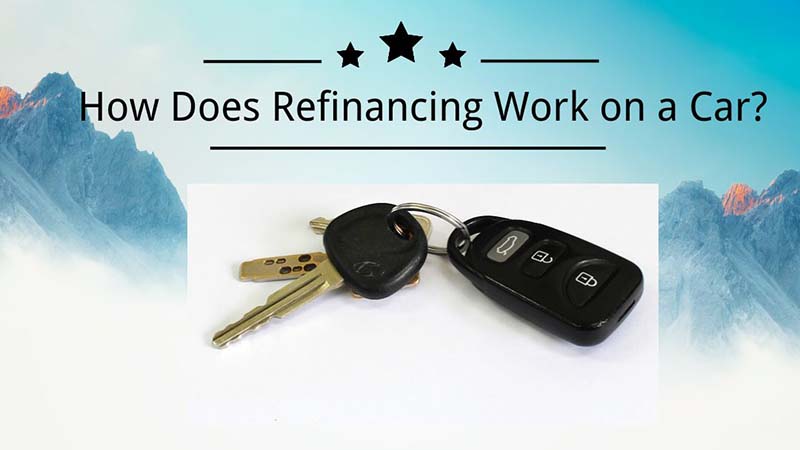Nowadays, the term “refinancing” is frequently used. Everyone is talking about low interest rates, whether they are refinancing their mortgage or their student loans. But what exactly is refinancing, and how does refinancing work on a car?
When you refinance a car, a new loan with new terms replaces your existing auto loan. In actuality, auto refinancing refers to the process of replacing your existing auto loan with a new one from a different lender. The results of this procedure for car owners can vary.
What is a Car Loan?
A secured loan known as a car loan can be used to finance either a new or used vehicle. Like other loans, a car loan functions in a similar manner. Your car will be purchased by a financial institution, and you will pay it back in a series of regular installments along with interest. Your car serves as collateral, and it will be taken away if you are unable to make payments to the lender for any reason. It’s because these loans have this collateral that they’re considered “secured.”
What is Refinancing?
Refinancing is the process of replacing an existing loan with a new one that has better terms. Refinancing a car to better terms often results in saving money, either in the long run by reducing the payment period or interest rate, or in the short term by reducing monthly payments.

Benefits of Refinancing a Car Loan
There are many benefits to refinancing a car loan, especially if it can result in cost savings. Here are a few of the most advantageous aspects of refinancing an auto loan.
Lowers Your Monthly Payment
A lower monthly payment is the main advantage of refinancing a car loan. Whether you qualify for a better interest rate, pay more toward the value of the vehicle, or extend the loan repayment period, refinancing is a great way to secure a more affordable monthly payment.
Imagine, for instance, that your current auto loan of $25,000 has a five percent interest rate, a six-year term, and a payment of about $400 per month. Your monthly payment would drop to about $375 if you refinanced the loan at a 2.5 percent interest rate. The payment would be further reduced to $300 a month by contributing an additional $5,000 to the loan’s principal. The monthly cost of the loan can be greatly altered by changing a number of loan-related variables.
Add Or Remove a Co-Signer
You might decide to refinance your current auto loan if it has a cosigner or co-borrower if you want to get rid of that person from the agreement. It’s possible that since you took out the loan, your financial situation has improved, or the co-signer is no longer in your life. Whatever the cause, car loan refinancing frequently makes it simpler to get rid of a cosigner without any problems.
To add a cosigner to a loan, borrowers can also refinance. The borrower may want to include their spouse on the loan because they recently got married, are in a different financial situation, or need additional support. Refinancing can make the process of deleting or adding a co-signer simpler in either case.

Pay Less in Interest
Being able to get a lower interest rate is another advantage of refinancing an auto loan. You pay less to borrow the money when you pay less in interest. If interest rates were high when you took out the loan or if your credit score has significantly increased, refinancing may allow you to get a loan with a much lower interest rate.
Read about
How Do You Refinance a Car?
If it seems like car refinancing might be a good idea for you, let’s go over how to start the process of refinancing. It’s a hassle-free process (especially when you use Auto Approve!) and can save you money in the short and long term.
Do Your Research
Make sure you are as prepared as you can be. Make sure your credit score is high by requesting a free credit report once a year. Verify that all of the information on your report is correct. If there are any errors or discrepancies, you can petition the credit bureau. Make sure you are aware of any penalties for which you may be liable by reviewing your current loan contract. If you have any inquiries or wish to review any of the fine print, contact your lender directly.
Apply to a Few Different Lenders
The application procedure is the same as when you first applied for your auto loan. You will need the following to get started:
- an ID with a photo, like a passport or driver’s license.
- The make, model, and year of your car, as well as the bill of sale and the VIN number.
- Pay stubs, banking information, and your credit report are all acceptable forms of identification as proof of income and financial history.
- Proof of residence, such as a lease, utility bill, or mortgage statement. PO boxes should be noted as being ineligible as residence proof.
- Proof of insurance.
Compare Rates
After all of your applications are submitted, you should start hearing back with different car loan APRs and terms. Choose the offer that offers you the best rate and makes the most sense for your specific circumstances after comparing all of your options. One of our representatives will walk you through the best options when you use Auto Approve for this process and ensure that you fully comprehend your new contract. (Oh, and when you refinance with Auto Approve, there are no mark-ups, so you’re actually getting the best rate available every time!)

Sign and Start Saving Money
Once you have picked the best car refinancing option, sign on the dotted line and start seeing the benefits of refinancing immediately.
Read about Pros and Cons of Refinancing Your Car
What to Do If You Can’t Refinance?
If you don’t qualify for auto loan refinancing, you might want to consider these options:
Sell the Car
If you’re having trouble making your auto loan payments, you can sell your car and use the money from the sale to pay off the loan. The problem might not be fully resolved, though, if you owe more money than the car is worth.
Renegotiate the Loan Terms
If you describe your current situation to your lender, they may be willing to renegotiate the terms of the loan. Until you have more money in the bank, you might be able to put a hold on your payments for a few months. In order to help you get a lower monthly payment without refinancing, some lenders can also change the loan terms.
Voluntary Repossession
When you surrender your vehicle to the lender voluntarily, they are free to sell it and collect any outstanding debt from you. This is an option if you want to pay off your loan quickly but can’t sell your car. It should only be used as a last resort though because voluntary repossession affects your credit.
Last, How Does Refinancing Work on a Car?
Your current auto loan will be replaced with a new one if you refinance your vehicle. You start making monthly payments on the new loan once your old loan is paid off. Refinancing applications are easy to complete, and many lenders can/may make decisions quickly. But before you dive in, there are some things to think about.





